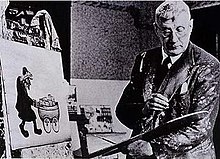Laurence Stephen Lowry | |
|---|---|
 Lowry at work | |
| Born | Laurence Stephen Lowry 1 November 1887 Stretford, Lancashire, England |
| Died | 23 February 1976 (aged 88) Glossop, Derbyshire, England |
| Education | Manchester Municipal College Salford Technical College |
| Known for | Painting |
| Notable work |
|
| Awards | |
Laurence Stephen Lowry RBA RA (/ˈlaʊri/ LAO-ree; 1 November 1887 – 23 February 1976) was an English artist. His drawings and paintings mainly depict Pendlebury, Greater Manchester (where he lived and worked for more than 40 years) as well as Salford and its vicinity.[1]
Lowry painted scenes of life in the industrial districts of North West England in the mid-20th century. He developed a distinctive style of painting and is best known for his urban landscapes peopled with human figures, often referred to as "matchstick men". He painted mysterious unpopulated landscapes, brooding portraits and the unpublished "marionette" works, which were only found after his death. He was fascinated by the sea, and painted pure seascapes, depicting only sea and sky, from the early 1940s.[2]
His use of stylised figures which cast no shadows, and lack of weather effects in many of his landscapes led critics to label him a naïve[3] "Sunday painter".[4][5][6][7]
Lowry holds the record for rejecting British honours—five, including a knighthood (1968). A collection of his work is on display in The Lowry, a purpose-built art gallery on Salford Quays. On 26 June 2013, a major retrospective opened at the Tate Britain in London, his first at the gallery; in 2014 his first solo exhibition outside the UK was held in Nanjing, China.
- ^ "L.S. Lowry | British painter". Encyclopedia Britannica. Retrieved 11 December 2020.
- ^ "LS Lowry rare Seaburn seascape sells for more than £1m". BBC News. 15 October 2022.
- ^ Jones, Jonathan (18 April 2011). "L. S. Lowry: The original grime artist". The Guardian. London. Retrieved 21 October 2011.
- ^ L. S. Lowry Retrospective Exhibition (Manchester: Manchester City Art Gallery, 1959)
- ^ L S Lowry RA: Retrospective Exhibition, (London: Arts Council, 1966)
- ^ Mervyn Levy, L. S. Lowry (London: Royal Academy of Art, 1976)
- ^ M. Leber and J. Sandling (eds.), L. S. Lowry Centenary Exhibition (Salford: Salford Museum & Art Gallery, 1987)